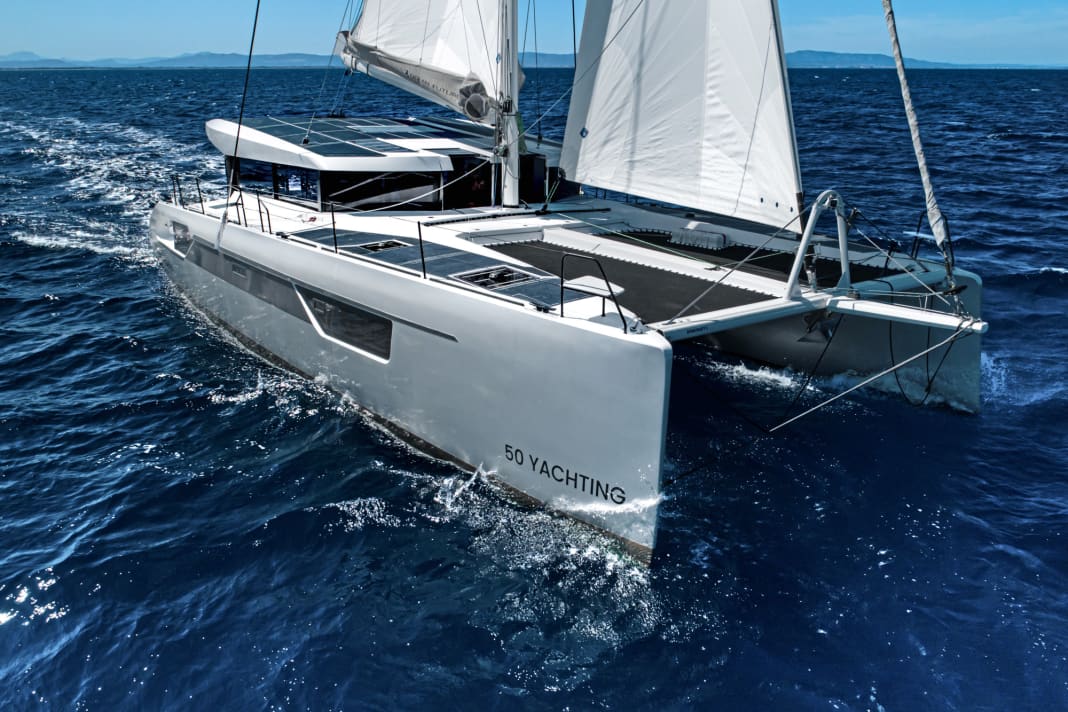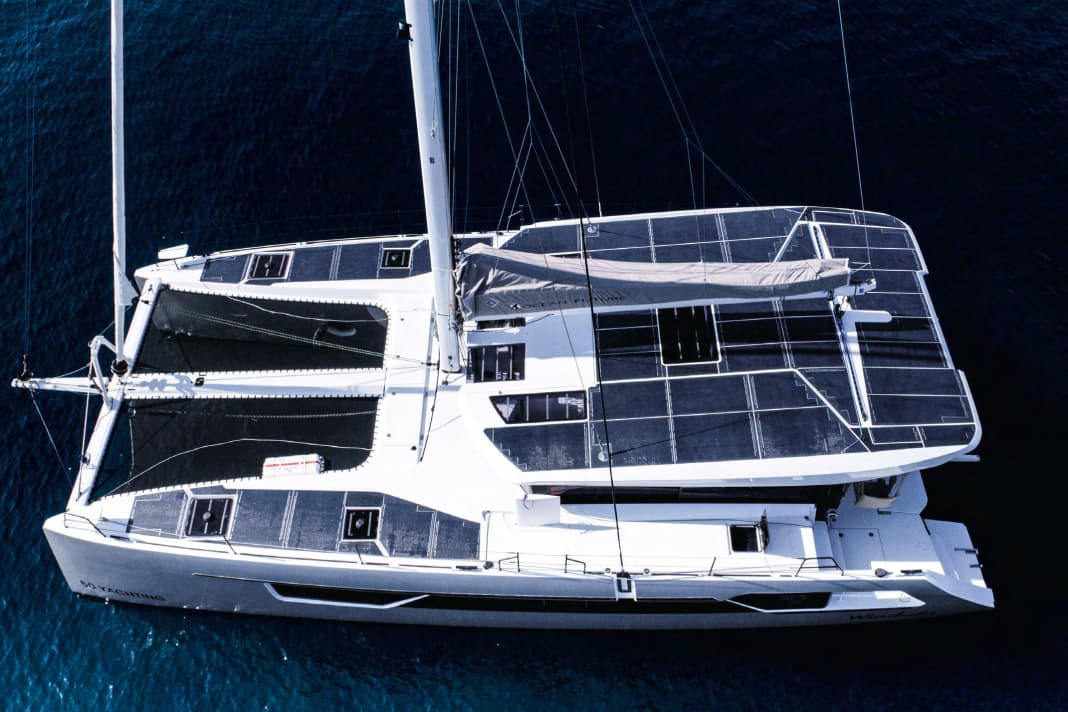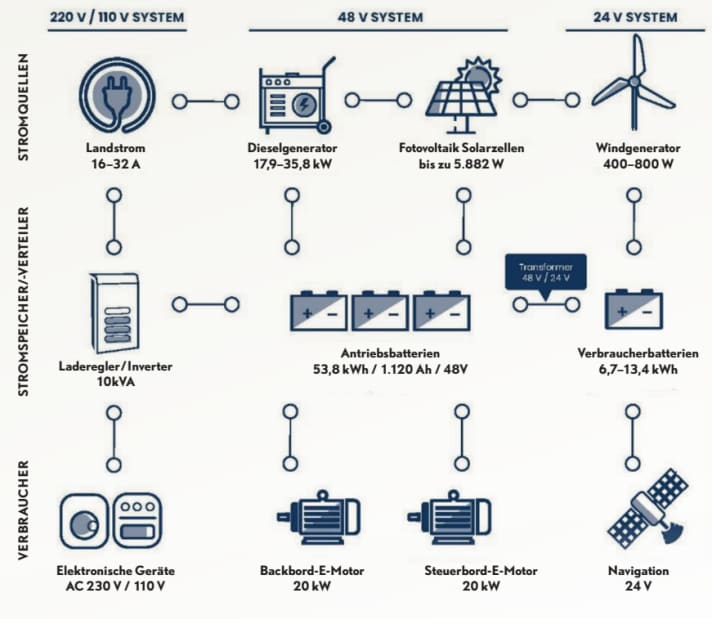Self-sufficient across the Atlantic: This Windelo 50 is designed to work without fossil fuels
Pascal Schürmann
· 13.01.2024






- The goal: a boat that works without fossil fuels
- The owners got to know the boat from the ground up
- The destinations: Caribbean, US East Coast - and back to the Mediterranean
- This is the energy concept of the catalytic converter
- This is how long it takes to recharge the cat's on-board batteries
- Further sustainable boat concepts
Stéphane Groves and his colleagues at the fledgling French shipyard Windelo probably didn't quite know how to deal with the apparent carelessness of their latest customer couple at first.
John Bibb, 54, and Barry Vial, 66, two US-Americans, sent the shipyard team a cheerful WhatsApp message from on board. They were on their way with their brand new Windelo 50 "Joule" - nomen est omen - from Lanzarote to Las Palmas, the island capital of Gran Canaria, over 100 nautical miles away.
Now they reported that they had switched on the water maker. And the washing machine. Twice in a row. The freezer was also working at full speed, they had defrosted it shortly before leaving, filled it with plenty of provisions and now switched it on again. Oh yes, and the tumble dryer is also running. The crew had showered, not forgetting the two hot meals that J., as John is known to everyone, had prepared on the electric cooker. Afterwards, of course, the dishwasher was also put into operation.
Numerous devices cause immense power consumption
Even a layman who is not able to quantify the power consumption of various household appliances will realise that a considerable number of kilowatt hours must have been consumed. At least ten, if not more. And that's not even counting the energy required for the navigation electronics, the autopilot and the electric motors that run for two and a half hours in the absence of sufficient wind.
"Despite all this, they hadn't even cast off with full batteries. The battery level in the last port was 73 per cent," says Windelo Managing Director Groves during a conversation a few days later in the port of Las Palmas. He is sitting on board the "Joule", together with the couple who have just moved their centre of life to the catamaran.
The two men had previously lived together on a two-hull boat. But: "It wasn't the same. It was a boat that we had bought in America from a large charter fleet operator - more of a motor sailer, a houseboat. It couldn't actually sail," says J. They spent four years travelling northwards from the Caribbean up the entire American east coast and back down again, he reports.
"At some point, we did the maths and realised that we were blowing huge amounts of diesel into the air," adds his partner Barry. "So we started to look into the subject of electrification. However, implementing this on an existing boat is not easy, retrofitting is enormously expensive and basically hardly feasible in a satisfactory way."
The goal: a boat that works without fossil fuels
So a new boat was needed. One that would be as fossil-free as possible. "When J. and Barry wrote that they were running all the consumers, I felt a little queasy," Groves admits openly. "It was an endurance test for the entire energy system on board, which we hadn't actually planned in this form."
The ship passed it with flying colours. "The solar cells and the recuperation via the two electric motors actually recharged the batteries so well that we arrived here with the same battery level as we read on the battery monitor when we set off just under a day earlier," says J., adding: "That alone would have been enough to continue sailing for a few more hours with just the electric motors if the wind had suddenly stopped."
We were looking for a catamaran that is equipped with electric drives - and that also sails well!"
When they were looking for a new catamaran, two aspects were important to them: "The boat should have an electric drive. And it had to be able to sail," reports Barry. "We were fed up with motoring around all the time."
Sustainable shipbuilding was important to the owners
They had several models on the shortlist, but in the end the decision was made in favour of the 50-footer from Windelo. Apart from a prototype of sorts, which was completed in 2021, the "Joule" is one of three ships in the new shipyard series. There is also the larger 54-footer, which has also been improved and relaunched, the first of which entered the water at the end of November. Windelo was founded in 2019 and the shipyard is located in Canet-en-Roussillon near Perpignan close to the French-Spanish border.
In addition to the energy concept and the promised sailing performance, the decisive factor for J. and Barry was a third aspect that was not available elsewhere in this combination: the idea of sustainability in shipbuilding. "We manufacture the hulls and deck from basalt fibre, in the form of a sandwich structure. The inner layers of the hulls consist of 56 per cent PET foam made from recycled plastic," explains Stéphane Groves. Conventional PVC foam has to be used for the remaining 44 per cent of the sandwich structure due to its greater strength. For the deck, on the other hand, only recycled PET is used for the intermediate layer.
"Energy self-sufficiency, sailing performance and environmentally friendly construction - all that together convinced us. Even though we realised that we would be the first to try out the concept for more than just coastal sailing," says J. He continues: "Sailing and living permanently on a boat is not just about freedom. It's also about responsibility. Towards nature. Towards our fellow human beings."
The owners got to know the boat from the ground up
As there had been delays at the shipyard due to the recent coronavirus crisis, the two were able to accompany the completion of construction. "That was actually helpful in the end, because we were able to see a lot of where and how the technology was installed. As a buyer, you usually don't see any of this on a finished boat," explains J.
They then sailed in the Mediterranean in September and October to familiarise themselves with the boat. "The learning curve was steep, but now we feel ready for the Atlantic," says Barry. They were particularly battered on the last leg to Las Palmas. "We had extremely strong gusts that made us feel uneasy. The boat, on the other hand, took it all in its stride as if nothing was wrong. That impressed us."
They have already logged speeds of over 15 knots. "But it's not our ambition to sail fast. And we certainly don't want to compete against the elements," explains Barry, who is the more cautious of the two. After all, sailing is not a battle against nature. Nature would always win in the end anyway. Barry: "Sailing is about working together - with the wind, the waves, the water."
In the end, one of the decisive factors was that the sustainability aspect plays such a major role in the construction of the boat"
On 19 November, J. and Barry set off for Saint Lucia on the "Joule" together with three friends. They took advantage of the annual Atlantic Rally for Cruisers to avoid having to cross the vast ocean on their own. "After all, this is our first time crossing the Atlantic. Sailing in a large group gives us a sense of security," says Barry the day before the start about her reasons for taking part in the ARC. "There is also a wealth of experience here among the other sailors and with the organiser, the World Cruising Club. People give you knowledge about all aspects of long-distance sailing."
The destinations: Caribbean, US East Coast- and back to the Mediterranean
The two have not yet decided what to do next. Perhaps back up the US coast before the hurricane season. "But we definitely want to go back to Europe at some point, to the Mediterranean. There's so much we haven't seen there yet. And we really enjoyed the short time we spent there in the summer. We especially loved the Greek islands," enthuses Barry.
But first, 2,700 nautical miles non-stop to Saint Lucia. Should the wind fail to materialise en route and the sun not shine, a diesel generator is on board for safety. "But we haven't needed it yet. And I'm assuming that it will stay that way," says J. They only need petrol for the dinghy outboard, he explains. "But only because the electric outboard motor that we would like to have was not available in a hurry. That really annoys me. The petrol engine will be off the boat in the USA at the latest!"
On board - and J. is a little proud of this - is his sextant, despite all the modern navigation electronics. J.: "When my father took me sailing when I was a child and I was still doing my first licences, I learned everything from him. However, I doubt whether I could still navigate by the stars today. I'd have to familiarise myself with it again. But the basic understanding is still there."
It seems that the two of them don't want to be completely dependent on all the technology after all - which speaks in their favour.
"Next time completely without diesel"
Epilogue: On 10 December, the crew of the "Joule" reached their destination on the Caribbean island of Saint Lucia safe and sound. It took them 21 days to cover 3,039 nautical miles. Their average speed was around six knots. This meant that they were neither among the fastest nor among the stragglers in the field of almost 160 boats that set off from Las Palmas at the same time as the ARC.
However, they had to pay tribute to the weak trade winds. J. Bibb reported after arrival: "I have to admit that we fired up the diesel generator from time to time. Even if only for eight hours. We could have done without it, but when everyone else around us was using their engines, we were worried about losing the connection."
After all, it was only their first Atlantic crossing. "Next time," says J., "hopefully we'll make it without diesel."
This is the energy concept of the catalytic converter
You don't have to be an electrical engineer, but it's not trivial either: the Windelo's energy concept is based on several components whose interaction is controlled and monitored





This is how long it takes to recharge the cat's on-board batteries
According to the shipyard's calculations, in order to recharge the empty on-board batteries to 80 per cent, it is necessary to either
- 24 hours the hydrogenerators run for a long time at a boat speed of at least 10 knots
- 17 hours sunshine falls on the solar cells or
- 8 hoursthe ship is connected to shore power or
- 3 hours the diesel generator runs.
Technical data Windelo 50 "Joule"
- Length: 15,24 m
- Width:7,95 m
- Draft (swords):1,03-2,32 m
- Weight: 11,2 t
- Mainsail: 92 m²
- Genoa: 43 m²
- Gennaker: 161 m²
- E-motors: 2x 20 kW
- Price (incl. 19 % VAT): from 1.3 million euros
Further sustainable boat concepts
The Windelo shipyard is not the only one pursuing promising approaches to minimise the CO2 footprint when building sailing yachts. In our sustainability special, we present various projects and approaches for more environmental awareness in sailing!

